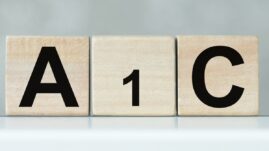Understanding your A1c and how it translates to an actual average blood sugar level is critical to diabetes management.

What is an estimated average glucose level?
Your Estimated Average Blood Glucose (eAG) represents the average blood sugar level over a period, typically mirroring the timeframe of the A1c.
You can use this simple eAG/A1c conversion chart from the American Diabetes Association (ADA) to instantly translate your latest A1c result into more easily understandable eAG results.
A1c to eAG chart
| A1c | eAG (mg/dL) | eAG (mmol/L) |
| 5 percent | 97 | 5.4 |
| 6 percent | 126 | 7.0 |
| 7 percent | 154 | 8.6 |
| 8 percent | 183 | 10.2 |
| 9 percent | 212 | 11.8 |
| 10 percent | 240 | 13.4 |
| 11 percent | 269 | 14.9 |
| 12 percent | 298 | 16.5 |
In general, the ADA recommends:
- a fasting blood sugar level of 80 to 130 mg/dL (4.4 to 7.2 mmol/L)
- a blood sugar level 1 to 2 hours after meals of less than 180 mg/dL (10.0 mmol/L)
- an A1c of less than 7.0 percent in people with diabetes.
Translating your A1c to a blood sugar level
Seeing an A1c result of, say, 8.0 percent might lead some to believe their glucose levels are consistently within their target range. However, a deeper look into what an A1c of 8.0 percent really translates to in terms of average blood sugar might reveal a different story.
An A1c of 8.0 percent corresponds to an eAG of approximately 183 mg/dL (10.1 mmol/L). This average is significantly higher than the ADA-recommended target for most non-pregnant adults, which is an eAG of less than 154 mg/dL (less than 8.6 mmol/L) or an A1c of less than 7.0 percent.
The discrepancy between an in-the-moment glucose reading and the 3-month average reflected by A1c can be surprising and highlights the importance of understanding both measures in diabetes management.
By translating your A1c into an eAG, you gain a clearer picture of your overall blood sugar management, beyond what daily readings can show. This additional perspective is helpful for making informed adjustments to your diabetes care plan.
Determining your own A1c and eAG goals
In an ideal world, our A1cs would all be a magical 5.0. But managing diabetes can be challenging.
This means that determining the right A1c goal for you, your body, and your life as a person with diabetes is a very personal decision that you and your healthcare team must work together to decide on.
For instance, someone with a history of hypoglycemia unawareness (the inability to detect the early signs of low blood glucose) may find a target A1c of 6.0 percent to be too dangerous, putting them at too much risk for severe hypoglycemia.
Someone who lives by themselves may find that sleeping with blood sugars lower than 120 mg/dL, for example, puts them at higher risk for hypoglycemia.
For people who have been running blood glucose levels higher than 240 mg/dL, the goal may be to gradually lower their blood glucose levels with the help of their healthcare team.
This means their A1c is going to be set at a higher target than “normal,” too.
Whatever your blood sugar targets, they should be periodically reviewed and adjusted, as necessary, in collaboration with your healthcare team to reflect any changes in your health status, lifestyle, or diabetes management needs.
To learn more about setting and achieving realistic A1c goals, you can watch this video where Christel Oerum, the founder of Diabetes Strong, explains how she keeps her A1c at her target range by following 5 simple steps:
How often should you have an A1c test?
If you are living with diabetes, your healthcare provider may order an A1c test for you somewhere between two and four times a year, depending on factors such as your level of blood sugar management and frequency of severe hypoglycemia (low blood sugar) or hyperglycemia (high blood sugar).
Learn about home A1c tests in: How to Measure Your A1c at Home.





Victoria Ramsey
I really don’t know what to say right now so I’m going to leave my information get back with me I’m a diabetic I need more information on what to eat how to eat it and how often to eat it so I’ll leave my name and my email and just get back with me as soon as possible thanks
Christel Oerum
Sounds like you’d benefit from working with a registered dietitian who understands diabetes. I suggest you reach out to Ben Tzeel (ben@yourdiabetesinsider.com) or have your doctor refer you to one
Brista Torris
Thanks For Sharing Such a great article . Actually after being a patient of diabetes cant find solution to cure it . Your article really helped me out.